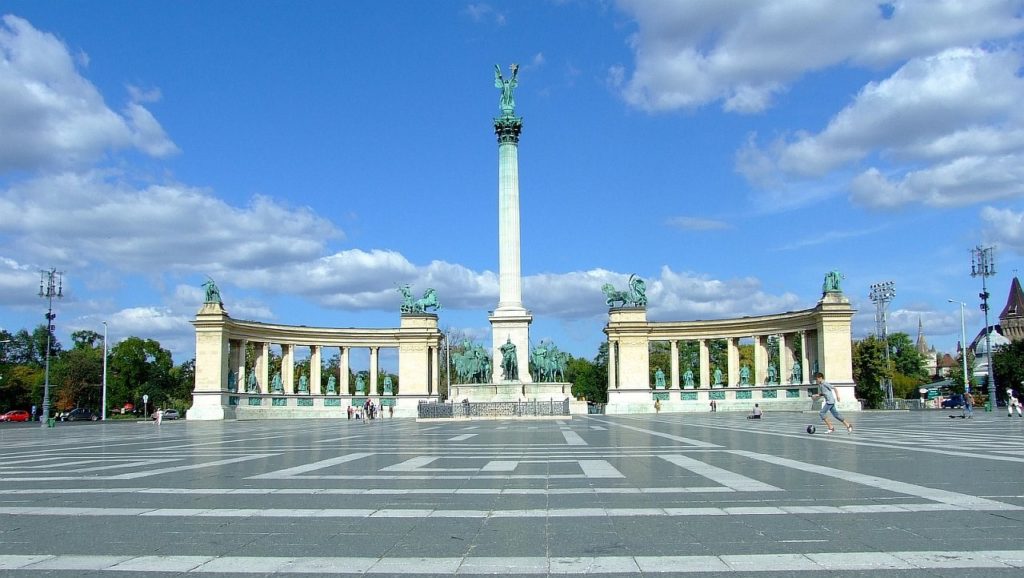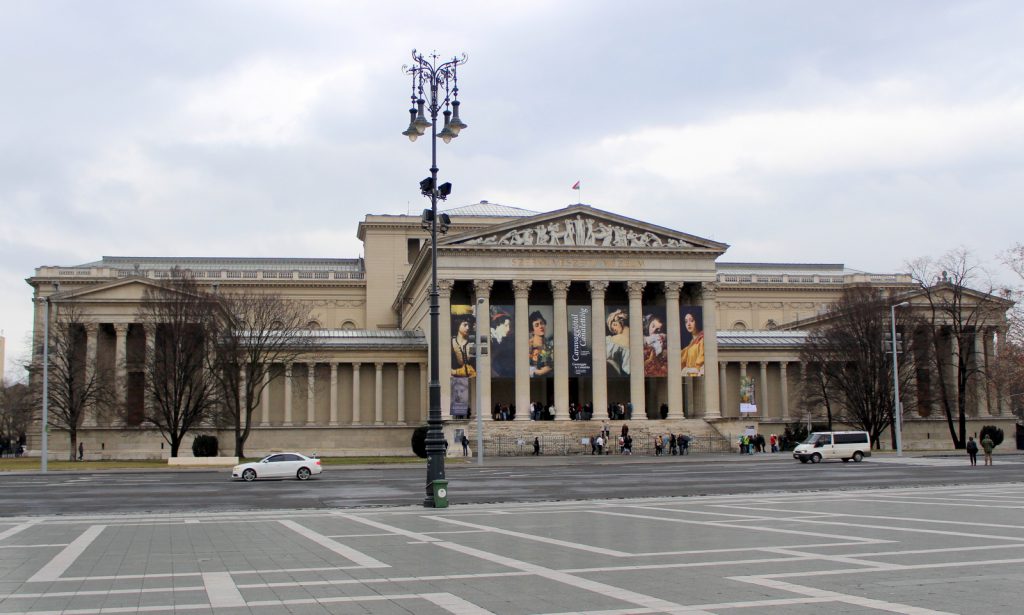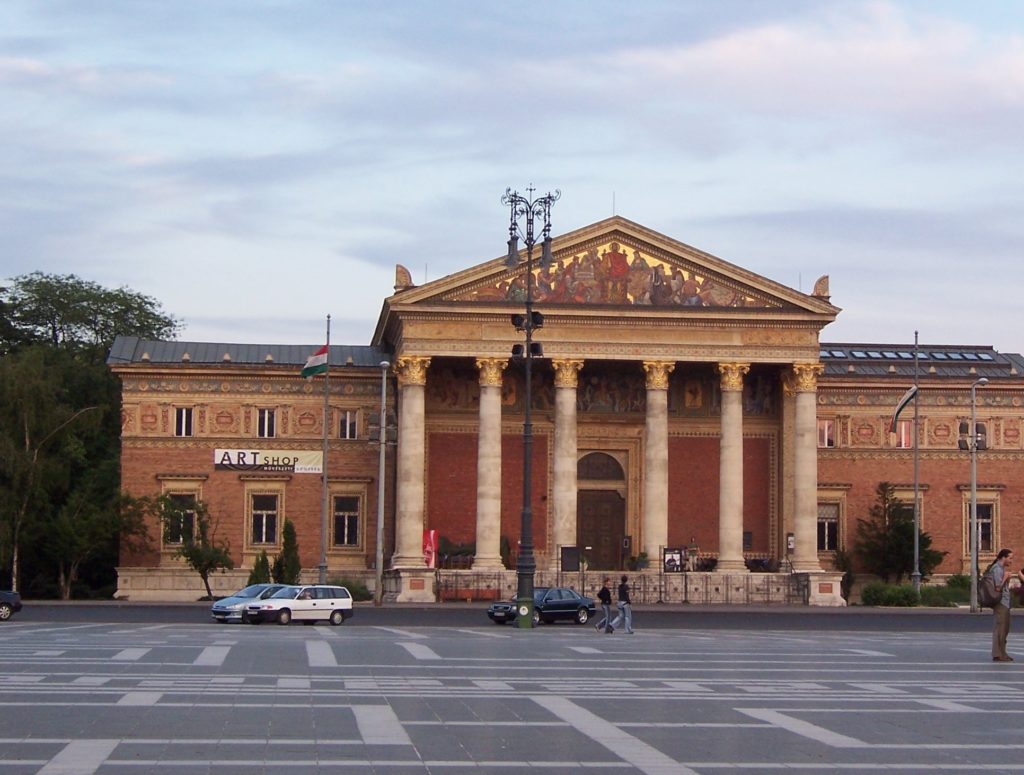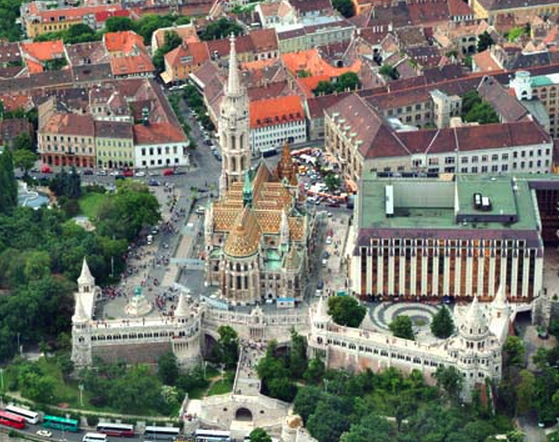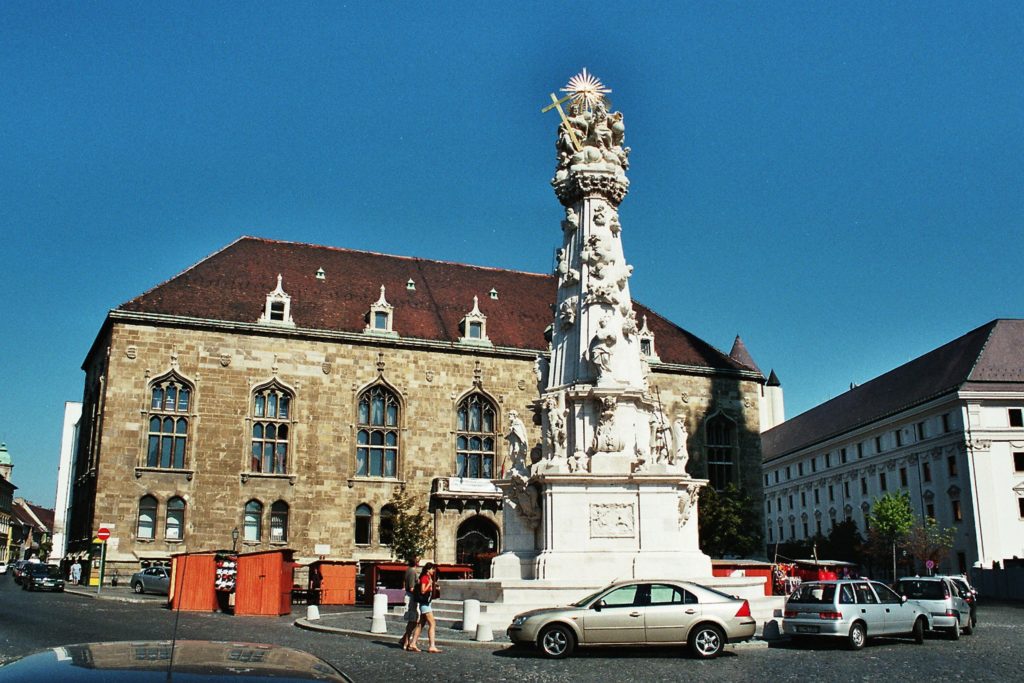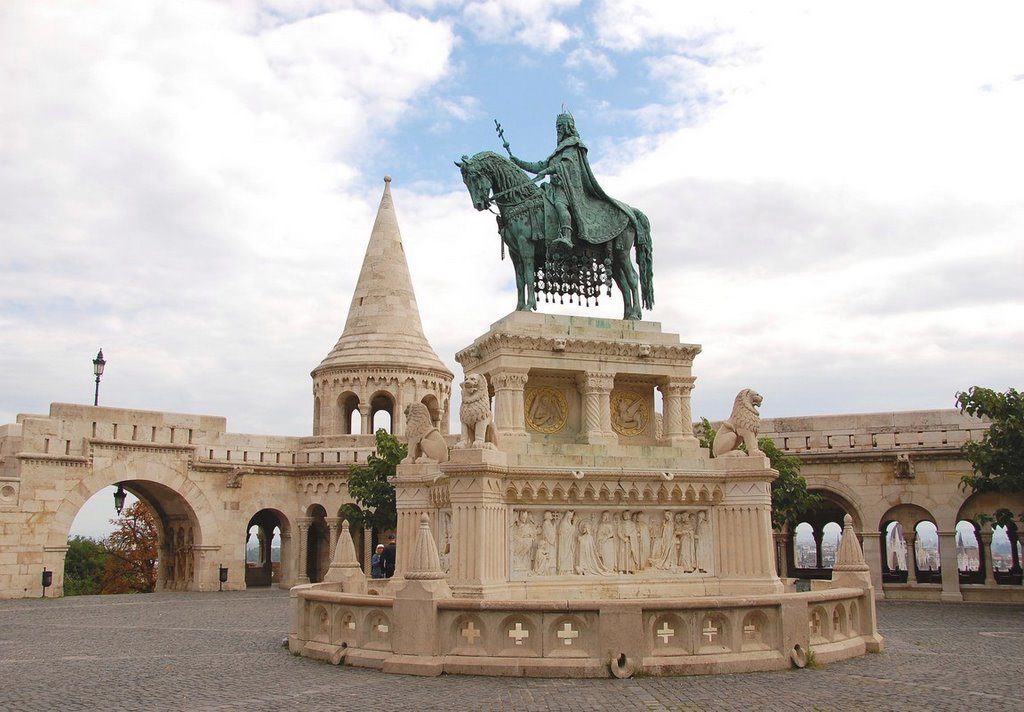Andrássy Street – a closer look
We saw this monument from a distance
It’s hard to notice without enlarging the photo (which you can do by clicking on it) but in front of both the column and the colonnade that comprise the Millennium Memorial (also called the Millennium Monument), there’s a small fenced off area. This is, in fact, a cenotaph that’s sometimes called Tomb of the Unknowns. It’s more correctly called the Monument of National Heroes and is dedicated, “To the memory of the heroes who gave their lives for the freedom of our people and our national independence.” However, it is a cenotaph. Hence, no one is buried here.
Construction of the monument began in 1896 to mark the one thousandth anniversary of the Magyar conquest of the Carpathian Basin and was completed four years later. Initially, the last five spaces on the left were reserved for members of the Habsburg dynasty. Remember, Hungary was, at this time, still part of Austro-Hungary.
Like so much else in Budapest, the monument was severely damaged in World War II. When the post-war Hungarians rebuilt it, figures from Hungarian history replaced the Austrians. So at least five of the fourteen figures in the colonnade have been added since the end of that war. There’s an important event from each hero’s life depicted in a relief below his spot on the colonnade.
Before moving on, here are a few other facts about the square and the monument. The statue at the top of the far left of the left side colonnade is the Couple of Labor and Wealth and on the right side is a man with a snake who represents war. Facing him on the right section of the colonnade is a woman in a chariot who is a symbol of peace and on the far right are the Couple of Knowledge and Glory. The figure at the top of the column is the Archangel Gabriel who holds the Hungarian Holy Crown in one hand and the apostolic double cross in the other.
The square is flanked by two important buildings. Had we approached from the direction of the photo above, the Museum of Fine Arts seen in this older photo
would have been on our left. (The museum was being renovated at the time of our visit and isn’t scheduled to reopen until sometime in 2018.) On the right is the Kunsthalle – sometimes called the Hall of Art and sometimes the Palace of Art. It primarily displays contemporary art.
And zen ve vent to Buda
Now it’s time to board a public bus that we’ll ride across the river for, as it turns out, our (meaning Pat’s and my) only visit to Buda. We’d get a good look at each of the four sections of Andrássy Street as we rode southwest toward the Opera House. Eventually, we’d cross the Danube over the Chain Bridge into Buda skirting the Castle itself before climbing the hill toward the Square of the Holy Trinity or, in Hungarian, Szentháromság Square (Go ahead. Say it. I dare you!) where we’d find Matthias’ Church, the Statue of St. Stephen, and the Fisherman’s Bastion with its spectacular views of Pest.
The history of Matthias’ church, also called “The Church of Mary” or “The Church of Our Lady” is more than a bit muddled. First, there’s the assertion that Saint Stephen built the first church on this site in 1015. If, as local history dictates, this first church was destroyed by the Mongols in 1241, the Asian invaders did an exceptionally thorough job because no archaeological evidence survives to support either notion.
Sometime around 1245, King Béla IV founded the city of Buda (remember from the first history lesson that the Mongols withdrew from Europe in 1242 when Ögedei Khan died) and construction of the present church proceeded in two phases – one beginning in 1250 and the other in 1270.
By the 14th century, this was the Royal Church. Although the coronations took place in the royal city of Szekesfehervar – some 65 kilometers south of Buda – the newly crowned kings then returned to Buda and entered the Church of Our Lady with the crown on their heads to be presented to the people of the country, as confirmation of the legitimacy of their power.
In the late 14th century, the church was reconstructed in the florid high Gothic style we see today. At this time, building was transformed from its earlier cathedral style into a hall church.
More additions were built in the 15th century and in 1443 the Buda town council ordered colored, glazed tiles and wood from Vienna to reconstruct the church roof. Mátyás (Matthias) Hunyadi, who had been named King in 1458 and for whom the church would eventually be named, added a royal oratory to the south side chancel. Also, work on the southern bell tower (seen above) began sometime in the 1460s during his reign.
Then came the Turks. They conquered the city of Buda 1541 and the church was quickly converted to a mosque. The altars and statues were thrown out, the walls whitewashed and covered with carpets, and a stone wall was built to hide a statue of the Virgin Mary.
This last fact is important in the legend of the church. The Army of the Sacred League (aka, the Holy League) recaptured Buda in 1686. On 2 September, with cannon fire shaking the city, that same stone wall collapsed creating the moment known as the “Mary-Wonder.” It’s said that soldiers of the Turkish Army, praying in church turned mosque, became so dismayed when the Madonna sculpture appeared that their morale plummeted and the city was retaken that very day.
Although work began to restore the church in the late 17th and early 18th centuries, both the citizenry and the ruling powers viewed that work as second rate. It wasn’t until 1874, in a process that required more than two decades, that restoration began in earnest and restored the edifice to its former glory. Then, after being used as a camp by both the German and Soviet armies the building required a second restoration from damage it suffered during World War II. Work began in 1950 with most of the funding supplied by the Hungarian government. Once again, the restoration required two decades to complete.
Pat and the others went into the church but I waited outside. (I know the important role churches and cathedrals play in European history and culture but I don’t hold a particularly favorable view of religion in general and I’d passed my interior church visiting tolerance level somewhere in Croatia.)
Adjacent to Matthias’ Church is the Fisherman’s Bastion (or, in another of those great Hungarian words, Halászbástya). The area received this moniker because it’s said that a guild of fishermen was responsible for defending this stretch of Castle Hill and the castle walls beginning from the Middle Ages. The fishermen lived below in an area between the river and the castle walls that was sometimes called Fishtown or, more properly, Víziváros which translates as Watertown. (Once an independent town, the neighborhood, which is now a part of Buda, is still called Víziváros.) Historians have concluded that the fishermen would pass through a small gate cand climb the hill to take part in the castle’s defense. However, while there was some form of bastion dating from the Middle Ages, the fanciful seven turreted terrace and walkway occupying the space today isn’t nearly as ancient.
In fact, the structures in place today were originally built between 1896 and 1902. Yes, 1896 was quite a party for Hungary. Recall that only a few paragraphs ago, I noted the construction of the Millennium Monument on the Pest side of the Danube. On the Buda side, they built the Fisherman’s Bastion – a neo-Gothic and neo-Romanesque mash-up that overlooks Pest and the Danube. (I lifted this nifty aerial photo taken by Civertan Studios from the Fisherman’s Bastion official website.)
Matthias’ Church is easy to spot as are six of the seven turrets. The seven turrets symbolize the seven Magyar tribes that settled in the Carpathian Basin in 896.
I’ve inserted two You Tube videos you can watch if you’re so inclined. The first is a three-minute walk through the promenade
and the second, only about a minute long, has one graphic that made me smile. I hope you’ll feel the same.
Two other notable works stand near Matthias’ Church. One is the Holy Trinity Column, that gives Szentháromság Square in front of the church its name. This monument was completed in 1713 to commemorate the end of an outbreak of Plague in Buda.
The other, a statue of St. Stephen, stands between the church and the bastion.
This marks the end of our guided tour. There’s plenty left before this day is done.
